Naval Tactic
We propose below some interesting articles that unravel between the various aspects of the strategy and naval tactics, it is very interesting to discover that many of these concepts remain valid also in the simulation that Admiral aspires to represent:
Cut the T
The "T" cut is a naval war tactic in which a line of warship crosses in front of a line of enemy ships like a "T", allowing it to use only bow weapons but receiving fire from all side edges of the enemy fleet. In this way you can make the most of the shooting of their cannon minimizing the chances of defense of the opponent. It became possible between the late nineteenth and early twentieth centuries as a result of the introduction of motor ships that had rotating artillery pieces on turrets and a maneuvering capacity superior to sailing ships. This tactic lost importance when missiles and planes allowed long-distance shots.
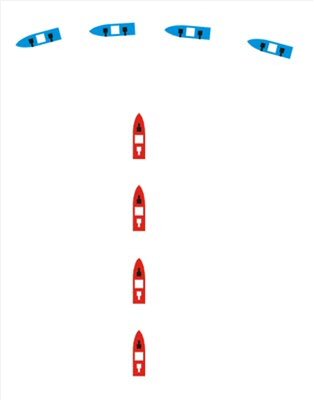
When placed at the battle, the ships take on the battle line formation in which the vessels line up in single file on one or more parallel lines. This arrangement ensures that each ship has the ability to shoot at a wide angle without running the risk of hitting friendly ships. Each ship is generally opposed to another of the enemy lineup. Crossing the enemy line with the tactic of the T cut you have the ability to shoot with the arms of bow and stern thus doubling the power of the fire thus maximizing the chances of reaching the target. The crossing maneuver is also less dangerous for those who implement it and extremely serious for those who suffer it. This tactic was designed for large heavily armed and armored battleships and was successfully used alternately by heavy cruisers.
Illusion of Advantage
Common tendency is to transpose terrestrial combat tactics in the naval field. Fatally some of these tactics not only do not give the expected benefits but fatally benefit the opponent. One of the most common mistakes is to delude oneself that attacking an opponent with a crossfire gives an advantage as in land combat, nothing more wrong.
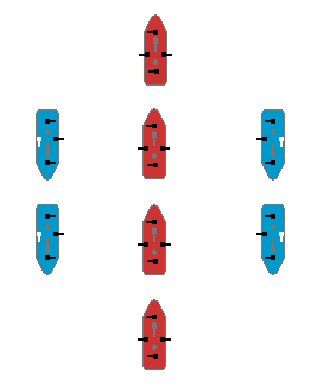
In fact, as we can see from the schematization blue ships do not get any advantage in terms of cannons used breaking their attack on two sides, also the red ships can thus fully exploit all the cannons available to them obtaining a considerable advantage.
Returning to a classic approach, however, you will notice that you will not be able to exploit all the pieces on the ships, but you will manage to make sure that our opponent can not do it either. As a general concept every commander must maneuver to make sure that you can shoot with as many pieces as possible and in parallel make sure that your opponent is unable to do so. As for the cutting of the T this setting does not guarantee victory, but significantly increases the odds.
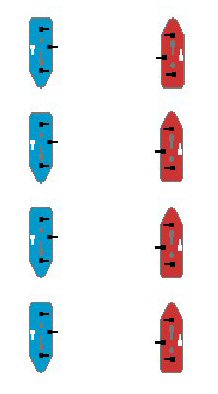
The Right Distance
Broadly on a warship you can distinguish two types of armor, the vertical and the horizontal. The inclination of an armor depends on the greater the section that protects, for example the armor of the hull will be vertical while that of the horizontal bridge.

In addition to the value of armor combined with its inclination, a third factor must be considered, it is the distance from which we open the fire. In fact, as we can see from the image, the distance from which we shoot influences the thickness of the shell that the projectile will have to penetrate.
Consider for simplicity the armor of the bridge, the closer we will be to our target plus our shot will come to angled sign compared to the bridge that as we said is horizontal, so as we can see the total armor that our shot will pierce "Green arrows" will be practically double compared to the actual one.
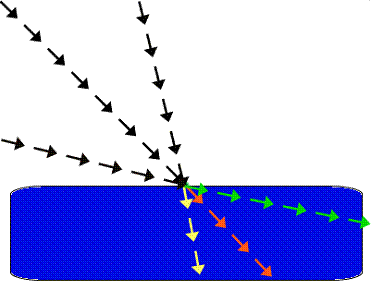
On the contrary, hitting from far away the shot will fall almost perpendicular finding in front only if the nominal thickness "Yellow Arrows".
That said we can state that depending on the caliber of a cannon and the armor distribution in the various sections with different inclination, there is an optimal distance from which to fire.
Instinctively we are led to think that as in most terrestrial situations it is always better to get as close as possible to our target because of the undeniable fact that the closer we are to the most powerful and penetrating target will be our blow.
In reality it is a bit more complicated, for example we consider a battleship, one of the vital sections of the ship, and that usually the bridge is not very protected due to practical reasons.
Suppose we attack the battleship with a cruiser that is certainly fast but not equipped with large-caliber pieces.
Approaching too much would risk, given the gap between the caliber of our guns and armor of the battleship, not being able to pierce the vertical sections and no longer have the ability to pierce the horizontal because of what we have just said.
Also approaching too much the possibility of hitting horizontal sections will collapse decisively in favor of vertical ones placing our ship in the impossibility to inflict damage to the enemy, which however at a short distance will have the possibility to fully utilize its destructive capacity of a possible artillery secondary or tertiary.
In fact, a 10-inch cannon will never penetrate a 21-inch armor placed on the hull from any distance he shoots.
On the contrary, the same cannon will easily penetrate a 5-inch armor of a bridge hitting it with a shot that reaches perpendicular and then fired from a long distance, which on the contrary would have no effect if shot at very short range as it would meet due to the angle practically double armored.
Focus the Fire
The first question that arises as soon as two naval groups come into contact is 'Who has to shoot Who'. In this case the biggest mistake that can be made is to distribute the firepower on the enemy units making it so incisive and not putting us in a position to get an advantage in a short time. Each vessel should try to maximize its use and focus on those units that can cause more damage. In an ideal situation, as Lord Nelson teaches, all units should focus the fire on a single enemy unit to make it powerless in the shortest possible time and thus gain a usable advantage.
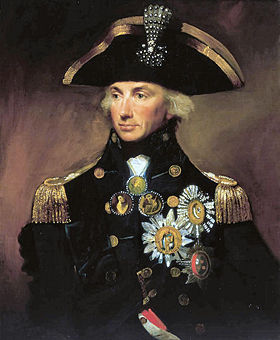
The choice of such or such units is always controversial, in fact there are three parameters that come into play in this evaluation and that many times come into conflict. The first is the ease with which we can eliminate the opponent and then get our advantage. The second is the danger of the adversary, the damage that can get us if left undisturbed. The third is not less important and time, that is, until we have to concentrate on a single unit, in fact it is not necessary to sink a ship but simply make it harmless or unable to generate significant damage to our forces. Always keeping in mind that the objective is to gain an advantage as soon as possible and to maintain it, each admiral will have to make an assessment that in many cases, depending on the scenario, may not be taken for granted. This is the measure, to evaluate the goodness of a commander.

